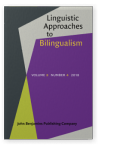Vol. 8:4 (2018) ► pp.411–445
Bidirectional cross-linguistic influence in late bilingualism
Evidence from the container-content relation
The container-content relation represents a set of nominal configurations unexplored in the acquisition literature. Whereas in English the switch from a noun-noun compound (water bottle) to a noun-prepositional phrase (bottle of water) is associated with a semantic shift from container to content, Spanish and Arabic adopt single canonical configurations for both conditions, noun-prepositional phrase and noun phrase, respectively. Importantly, Spanish, Arabic, and English display structural overlap in the content condition maintained by head-first isomorphic strings. In the container condition, they show structural dissimilarity; whereas English uses a head-final construction, Arabic and Spanish consistently use head-first constructions. Results from an elicited sentence-reordering task demonstrate that advanced late learners pattern native speakers when tested in Spanish but not when tested in English. Additionally, when tested in English, Arabic-speaking and Spanish-speaking learners overextend their L1 canonical configurations to both conditions. Furthermore, bilingual native speakers do not perform at ceiling, suggesting bidirectional cross-linguistic influence.
Article outline
- Introduction
- Background
- Structural phenomenon under consideration
- The container-content relation as a syntax-semantics interface property
- Nominal compounding in SLA studies
- Interface phenomena in SLA studies
- The present study
- Research questions and predictions
- Participant profile
- Methods and design
- Results
- Spanish-English bilinguals
- Arabic-English bilinguals
- Comparison between Spanish-English and Arabic-English bilinguals
- English monolingual group
- Discussion and conclusion
- Acknowledgements
- Note
-
References
